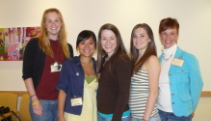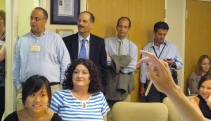
International Patient Meeting Report - 2008, Maryland, USA
A Gastro-Intestinal Stromal Tumour is rare, but you are not alone!
Conference On Paediatric GIST
The following report was written by Stefanie Peyk who is 35 years old, from Berlin. Stefanie is a member of the Executive Committee of "Das Lebenshaus"and has had Paediatric GIST since 1992.
We are very grateful to our member Michael Sayers for translating the above report from the original German.
Should you wish to get in contact with Stefanie, please write to peyk@lebenshauspost.org (She has excellent English!)
Blue Cars or Green Dinosaurs?
First US consultation for patients with paediatric GIST... it is the middle of June 2008, in the waiting room of a large clinic in Bethesda, Maryland. A young man in his early 20's displays his pressure bandage: "Look, I've been given a bandage with blue cars on it." So what? I've got green dinosaurs," a young woman replies. "Green Dinosaurs? Cool! I want green dinosaurs too!" says the young man. The patterns on plasters and bandages are a sure sign that we are in a children's ward. There is a relaxed atmosphere, none of those present look as if they are suffering.

14 GIST-patients aged between 10 and 35, most of them accompanied by relatives, have come for a special appointment/consultation, a consultation especially for patients with paediatric GIST. I am the only patient from Germany and I am the oldest person here. However, in all probability, I too have paediatric GIST.
Paediatric GIST is an extremely rare sub-variant of GIST, which in many respects differs from adult GIST: paediatric GIST is more prevalent among girls and young women than among boys and young men. Here in the clinic, 10 of the 14 patients are female. In the main, the illness starts in the stomach, where several primary tumours can present themselves in one go. There are more metastases in the lymph nodes than in the case of adults. In cases where the genetic make-up of the tumour cells is examined (so-called mutation analysis), typically no mutations are found in either gene, which are frequently altered in adult patients (KIT and PDGFRA). The doctors then talk about "Wild type GIST". Imatinib seems on the whole to work less effectively on patients with paediatric GIST than it does for adult patients. But there is also some good news: the tumours often grow more slowly and behave in a less aggressive way than their counterparts in adults. Young adults suffering from GIST can either have the paediatric form of GIST or the form more usually found in older adults.
Not all the patients here in the waiting room have paediatric GIST. Patients with Carney-Triad or Carney-Stratakis-Syndrome have also been invited. In both these illnesses, further tumours are found along with the paediatric GISTs. In cases of Carney-Stratakis-Syndrome there are found the so-called paragangliomas, tumours which originate in the nervous system. In patients with Carney-Triad, benign lung tumours (pulmonary chondromas) were observed along with GIST and paragangliomas) as well as, in some isolated cases, benign tumours of the suprarenal gland, (adenomas) and benign tumours of the oesophagus (leiomyomas). Patients suffering only from paediatric GIST may develop these other types of tumour over time. While Carney-Stratakis-Syndrome seems to be hereditary, it is not thought that the same applies to Carney-Triads.
 Medical science knows relatively little about these three illnesses: paediatric GIST, Carney-Stratakis-Syndrome and Carney-Triad. With a view to bringing this state of affairs to an end, the 14 patients have come to Bethesda. Bethesda is where the USA's National Institutes of Health (NIH) is based. The NIH is a medical research establishment of the USA's Health Ministry. One of the most recent research projects is to find out more about paediatric GIST and related illnesses. In order to achieve this aim, NIH researchers have got together with the two large American GIST-Patient organisations, Life Raft Group and GSI GIST Cancer International, as well as with GIST-Specialists in other American research institutes, to organise the first consultation for patients with paediatric GIST.
Medical science knows relatively little about these three illnesses: paediatric GIST, Carney-Stratakis-Syndrome and Carney-Triad. With a view to bringing this state of affairs to an end, the 14 patients have come to Bethesda. Bethesda is where the USA's National Institutes of Health (NIH) is based. The NIH is a medical research establishment of the USA's Health Ministry. One of the most recent research projects is to find out more about paediatric GIST and related illnesses. In order to achieve this aim, NIH researchers have got together with the two large American GIST-Patient organisations, Life Raft Group and GSI GIST Cancer International, as well as with GIST-Specialists in other American research institutes, to organise the first consultation for patients with paediatric GIST.
Here we are examined: measured, weighed, blood taken and they ask us about our family history of diseases. An immediate advantage of the consultation for us patients: we can pester selected specialists with questions - experts, who have already established themselves at the forefront of the studies of our disease. Among the doctors here present are well-known American GIST-experts such as George Demetri, an oncologist from the Dana Farber Cancer Center (Boston), Cristina Antonescu, a pathologist from the Memorial Sloan-Kettering Cancer Center (New York), Michael Laquaglia, a paediatric surgeon from the Memorial Sloan-Kettering Cancer Center (New York) and Constantine Stratakis, a geneticist und endocrinologist from the NIH - the Carney-Stratakis-Syndrome is named after him and his colleague Carney.
And the patients ask: "But I am still so young. Is it not therefore risky, to have a CT scan every 3 months? Doesn't the radiation build up over the years?" or: "I have now been tumour free for over a year. I tolerate Imatinib very badly. Must I still take it, despite this?" Every patient gets half an hour with the whole range of experts, including appointments with psychologists, nutrition advisers, social workers. As we wait, we patients have time to talk to each other and get to know one another. I already know many of the mothers here from the Internet: in the USA there is a Mail system especially for patients with paediatric GIST and those associated with them - comparable with the Das Lebenshaus Mail system and the GIST Cancer UK Mailtalk. It is lovely for once to meet these people face to face, people with whom I have already shared many sorrows as well as many joys. For us patients, therefore, the consultation is a winner, whatever happens.
 But why do the researchers go to all this trouble? OK, so they want to help us. And: they want to build up a medical database with the (protected) information of as many patients with paediatric GIST as possible, and perhaps including information about patients with Wild Type-GIST . This internet based, secure database should, for example, give information about disease progression, the response to or failure of therapy, about pathology and radiology findings. The data from us first 14 patients will form the foundation stone for the database; further consultations are planned. Besides this, the researchers hope that any patients, who could not come personally to Bethesda - such as patients from Europe, put off by the long journey - will make their data available to them for the purposes of research. With the aid of these data, which should regularly be updated, the researchers want to learn more about the causes of paediatric GIST - and they want to find better ways of treating the disease.
But why do the researchers go to all this trouble? OK, so they want to help us. And: they want to build up a medical database with the (protected) information of as many patients with paediatric GIST as possible, and perhaps including information about patients with Wild Type-GIST . This internet based, secure database should, for example, give information about disease progression, the response to or failure of therapy, about pathology and radiology findings. The data from us first 14 patients will form the foundation stone for the database; further consultations are planned. Besides this, the researchers hope that any patients, who could not come personally to Bethesda - such as patients from Europe, put off by the long journey - will make their data available to them for the purposes of research. With the aid of these data, which should regularly be updated, the researchers want to learn more about the causes of paediatric GIST - and they want to find better ways of treating the disease.
The doctors in Bethesda described another possible line of inquiry: recent research results show that a particular receptor, Growth Factor Receptor 1, (IGF-R1 for short), which is similar to insulin, is over-produced in Wild type GISTs, so that it seems to appear with unusual frequency on the tumour cells. Clinical studies with antibodies, which block this receptor in a targeted way, suggest a possible future option for patients with paediatric and Wild type-GIST.
We are all completely bemused by so many new things and so much new information. The pressure bandage with the blue cars and green dinosaurs has long since been put aside. What remains is the confident feeling of being in good hands, and the hope that the researchers here will succeed in their search for an effective treatment for our illness.
Since the consultation in June 2008, the scientists taking part have established the Consortium for Pediatric and Wildtype GIST Research, CPGR. Members of this consortium are:
The Dana Farber Cancer Institute in Boston
The Memorial Sloan-Kettering Cancer Center in New York
The Texas Children's Hospital in Houston
The National Institute of Health in Bethesda, Maryland.
The research consortium is open to other doctors and scientists interested in Paediatric and Wildtype GIST. The scientists who took part will meet together twice a year at the National Institute of Health.
Posted: 20/10/2008
